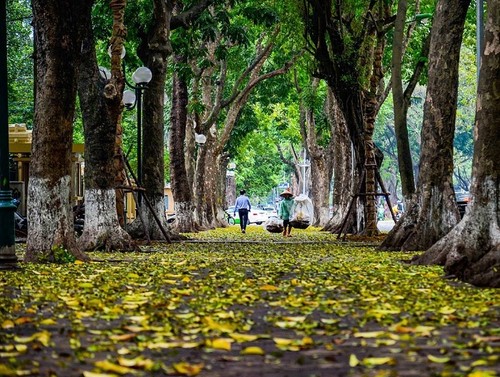 A Hanoi street in autumn A Hanoi street in autumn |
B: Listeners to VOV’s English section also tune in to Japanese, Chinese, Indonesian, German, Spanish, Russian, and French programs. They say each section has unique stories, in addition to the stories they were in common.
A: Fumito Hokamura of Japan told us that he listens to both the English and Japanese programs because he wants to learn more about Vietnam.
A: Lu Dacheng told us that he wrote a letter to the Chinese Section. He saw that it was published in the Letter Box in Chinese, but surprisingly, his feedback was also acknowledged in the Letter Box of the English section.
B: Lu, welcome to the English Section. We hope that you, a multi-lingual listener, will spend time tuning in to many VOV programs. By the way, your photos of China’s yellow forests, mountains, and rivers in autumn are awesome.
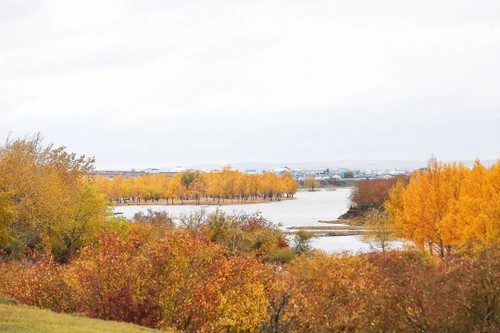 A picture of China's autumn that Lu Dacheng sent us. A picture of China's autumn that Lu Dacheng sent us. |
A: Hanoi is in autumn. The weather is cool and dry, but still sunny, from September to November before tuning cold. Autumn is more golden than the other seasons. Yellow and red trees line the city’s streets, the sky is bluer, and the sunshine looks like golden honey.
B: Jayanta Chakrabarty of India asked us about the 4 seasons in Vietnam. In each season, Hanoi has specific flowers and foods. Strong-smelling milk flowers and daisies are typical autumn flowers.
A: Winter in Hanoi begins in late November. It gets cold, with an average temperature of 15-17°C. Sometimes it drops below 10°C and the high humidity makes the air feel even colder.
B: Vietnamese people have a saying about the weather: In May it’s hard to get any sleep before the sun rises, and in October it’s hard to have any fun before it sets.
A: In winter the sky is often dark and gloomy. But that’s when Hanoi seems to have its busiest days of the year. Streets are more crowded than usual. Day and night people are rushing to tie up loose ends and prepare for the Tet or traditional new lunar year holiday. The cold weather prompts people in Hanoi to eat tasty hot foods like hotpot or grilled dishes.
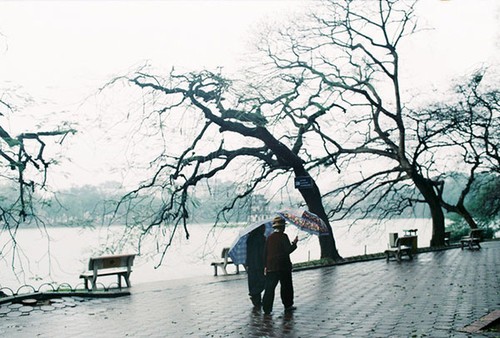 A scene of Hoan Kiem Lake in winter A scene of Hoan Kiem Lake in winter |
B: In late January and early February we can feel and see the spring, as trees bud and flowers blossom under light drizzles that continue most of the day.
A: Spring is the season of festivals and the Lunar New Year celebration. People all over Vietnam celebrate Tet – the biggest holiday in Vietnam. Peach blossoms are the flower of spring. Other flowers, such as roses, gladiolus, and narcissus are more beautiful than in any other season and many flower gardens open to the public so people can take photos.
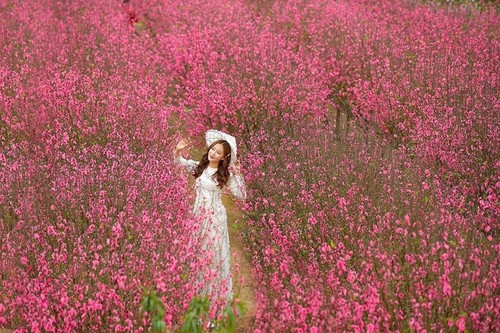 Peace blossom garden is a favorite place for people to take photo before the Lunar New Year Festival. Peace blossom garden is a favorite place for people to take photo before the Lunar New Year Festival. |
B: Hanoi’s summer often begins in the middle April but it really starts to get hot in May and stays hot until the end of August. July is usually the hottest month of the year, with the outside temperature reaching nearly 40 degree Celsius. Sudden, heavy rain is one feature of Hanoi’s summer. At least it brings the temperature down a bit.
A: Hanoi in summer is colorful with many kinds of flowers: white Madonna lilies in April, red flamboyants and violet Bang Lang flowers in May, and West Lake lotus in June.
B: Summer is the season of tropical fruits all across Vietnam and you can sample them all here in Hanoi: grapefruit, litchi, mango, watermelon, pineapple, starfruit, and many more.
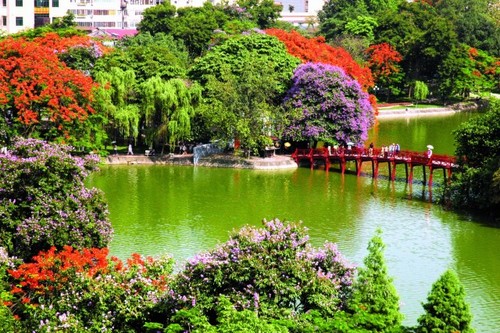 red flamboyants and violet Bang Lang flowers by Hoan Kiem lake in Hanoi red flamboyants and violet Bang Lang flowers by Hoan Kiem lake in Hanoi |
A: Each season in Vietnam has distinctive features which can hardly be described in a few minutes. We hope that when the COVID-19 pandemic is under control Vietnam opens its door to tourists again, many of you can visit Vietnam and experience these features for yourself.
B: Diego Echeverri of Colombia told us that he wants to hear more about Vietnamese coffee. He lives in a coffee plantation region. Many foreign tourists come to his place to learn about coffee growing and processing. Information about Vietnam’s coffee tourism would be useful for an article he is writing for a local newspaper, Echeverri said.
A: Vietnam’s Central Highlands has been dubbed 'Kingdom of Coffee'. It places Vietnam second among the world's top coffee exporters. The Central Highlands has more than 577,000 ha of coffee trees, nearly 90 percent of Vietnam’s total coffee area. Dak Lak province has the largest coffee area, more than 200,000 ha, followed by Lam Dong, Dak Nong and Gia Lai.
 The Central Highlands is Vietnam's Kingdom of Coffee. The Central Highlands is Vietnam's Kingdom of Coffee. |
B: They practice high-tech coffee production, have geographical indicators for coffee, and have established connections between farmers and distributors. The coffee harvest lasts from November to December. There is no specific coffee tourism in Vietnam, but almost everybody who comes to the Central Highlands visits the coffee farms and enjoys some of the local coffee.
A: A travel agency may introduce them to a particular coffee farm or they may just explore on their own. Visitors to Da Lat can book a half-day coffee tour at the K’Ho Coffee Farm and Roastery at a cost of about 30 USD per person, including lunch.
B: The garden cafe at K’Ho Coffee Farm is owned by 4th generation coffee farmer Rolan Co Lieng and her husband, who founded K'Ho Coffee as a family enterprise selling fresh-roasted, sustainably-grown, specialty-grade arabica coffee sourced directly from their community.
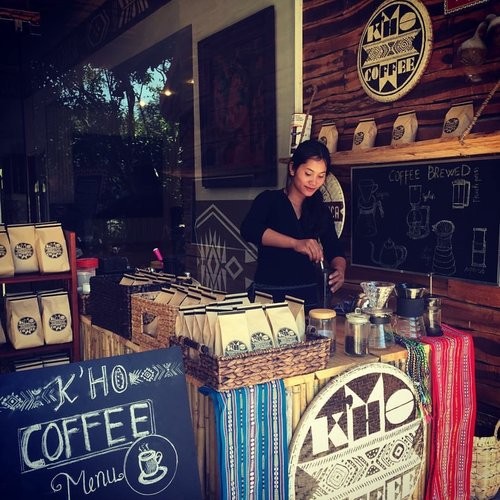 (photo: khocoffee) (photo: khocoffee) |
A: The K’Ho are one of Vietnam’s 54 ethnic groups. The French were the first to bring arabica seeds to Vietnam from Africa. In 1912, they established Da Lat as their own resort town and enlisted the ethnic K’Ho minority in the area to tend their coffee trees.
B: Daily half-day workshops demonstrate traditional methods of coffee processing from tree to cup. Visitors can try their hand at a little work, drink a lot of coffee, and learn something new about the coffee industry.
A: There are at least 15 steps in the creation of K’Ho coffee. After a quick introduction to the farm, you can walk between the rows of coffee trees, see the berries up close, learn about the varieties of arabica, and see agroforestry in action. Your guide will show you each stage in the process of coffee production, employing the same methods the K’Ho have used for years.
B: There are many such coffee gardens and workshops offering tourists an educational and fund experience of coffee growing, processing, and tasting.
A: Last week we received a reception report from Christer Brunström, who tuned in to our program on October 4th at 1600 UTC on 11885 kHz. He rated SINPO at 45443 and noted that the audio quality was somewhat better but certainly not perfect.
B: Thank you for your feedback. We’ll forward the information to our technicians.
A: Andrey Novgorodsky of Ukraine tuned in to our program on October 9th on the frequency of 7220 kHz. He said the overall quality was about 4.
B: Shivendul Paul of India emailed us to thank us for reading his letter on the Letter Box and answering his question about marriage traditions in Vietnam. He was very happy to learn about the marriage traditions of the Raglai matriarchal ethnic minority group in Vietnam’s Central Highlands. Paul said the signal on 7220 Khz on October 6th and 9th was good.
A: Thank you all for your feedback. We’ll forward your remarks to our technicians to see if they can improve the transmission.
B: We always welcome your feedback at: English Service, VOVWorld, the Voice of Vietnam, 45 Ba Trieu street, Hanoi, Vietnam. Or you can email us at: englishsection@vov.vn.
A: You can also leave your comments on our website at www.vovworld.vnor on our Facebook fanpage at VOV5 English Service. Thank you all. Stay safe and healthy. Goodbye!